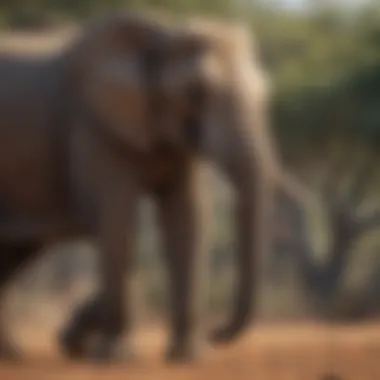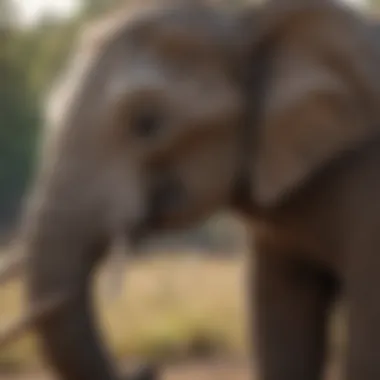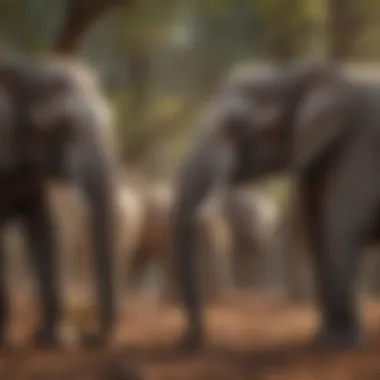The Current Status of Elephants in the World


Intro
Elephants are one of the most captivating creatures on Earth. Their size, intelligence, and social structures offer a unique window into the complexity of the animal kingdom. Unfortunately, these magnificent beings are facing significant challenges. Current population trends show a worrying decline, primarily driven by habitat loss and poaching for ivory. Understanding their status is crucial for fostering effective conservation efforts.
In this article, we delve into multiple facets of elephant populations worldwide. By exploring their fascinating facts, revealing their behaviors, uncovering recent scientific discoveries, and discussing their cultural significance, we aim to create a comprehensive overview. Our goal is to inform and raise awareness about the critical state of these animals, encouraging action for their preservation.
Fascinating Facts About the Animal
Elephants are not just large mammals; they hold distinctive traits that set them apart in the animal kingdom.
Unique Characteristics
Elephants possess unique physical features. Their trunks, an extension of the upper lip and nose, are multifunctional tools. They can use it to grab food, drink, and communicate. The ears of African elephants are larger than those of their Asian counterparts, which helps regulate body temperature. Their massive size is complemented by thick skin, but it is also sensitive to sunlight; elephants often apply mud for protection.
Extraordinary Abilities
Elephants show exceptional cognitive skills. They exhibit problem-solving abilities and strong social bonds. Studies reveal they have emotions similar to humans, often showing empathy and grief. This ability to connect with others is vital for their social structures. Such traits contribute to their role as a keystone species in their habitats.
Behavior and Habitat
The various behaviors elephants display greatly contribute to their survival.
Natural Habitats
Elephants inhabit different ecosystems, primarily savannas, forests, and grasslands. African elephants typically prefer open habitats, while Asian elephants are often found in dense forests. These habitats provide essential resources like water and food, which are crucial for their daily life.
Social Structures
Elephants live in matriarchal herds led by elder females. They exhibit complex social behaviors, including nurturing the young and collaborating during foraging. Males generally leave their natal groups upon reaching maturity, often leading a solitary life or forming temporary bachelor groups.
Recent Scientific Discoveries
Research on elephants has provided new insights into their behavior and biology.
Latest Research Findings
Recent studies indicate that elephants communicate using low-frequency sounds called infrasound. This allows them to communicate over long distances, unheard by humans. Additionally, studies showed that elephants display a remarkable memory, remembering water sources and routes over extensive periods.
Breakthroughs in Animal Biology
Genetic research has made strides in understanding elephant evolution. Learning about their ancestry can help conservationists better comprehend the unique adaptations of both African and Asian elephants. Such breakthroughs are important for formulating strategies to protect these species effectively.
Cultural Significance
The importance of elephants extends beyond biology, as they are deeply woven into human culture.
Animals in Folklore
In many cultures, elephants symbolize strength, wisdom, and loyalty. Their presence in folklore and mythology illustrates their revered status. For instance, in Hindu culture, Ganesha, who has an elephant's head, represents wisdom and protection.
Influence on Art and Literature
Elephants have inspired countless artists and writers throughout history. They appear in various art forms, from ancient sculptures to modern literature. Their essence has motivated many pieces that explore themes of strength, memory, and coexistence. This cultural significance enhances our understanding of their importance not only in ecosystems but also in human society.


Finale
As we examine the current status of elephants worldwide, it becomes clear that they face many threats but also possess exceptional qualities that inspire admiration. By understanding their intricacies, we can contribute to their conservation and ensure these extraordinary creatures continue to thrive.
Global Elephant Population Estimates
Understanding global elephant population estimates is crucial for effective conservation strategies. These estimates provide a foundational understanding of how many elephants exist today, how their populations are distributed across various regions, and which species are at greater risk. In addition, these figures underscore the urgency of ongoing conservation efforts. By analyzing global populations, stakeholders can prioritize areas for intervention, allocate resources effectively, and implement tailored strategies to protect these magnificent creatures.
Overview of Global Elephant Numbers
The global population of elephants is currently estimated to be between 400,000 to 500,000 individuals. However, this number is approximate and subject to change. The trend indicates a significant decline over the last century due to various factors, including poaching, habitat loss, and human-wildlife conflict. Capturing accurate population numbers is essential for safeguarding these animals. Such statistics help researchers and conservationists understand the effectiveness of existing programs, including anti-poaching initiatives and habitat restoration efforts.
Species-Specific Populations
Different species of elephants exhibit varying population trends, influenced by their habitats and human activities.
African Bush Elephants
African bush elephants are the largest of all elephant species. With an estimated population of around 300,000 individuals, they play a vital role in their ecosystems. Their habitat ranges from savannas to forests, where they help shape the landscape by uprooting trees and trampling vegetation, which facilitates a richer biodiversity. Unfortunately, they are severely threatened by poaching for ivory and habitat encroachment. Their large size and social nature makes them a focus of many conservation initiatives, emphasizing community-based programs that aim to protect both the elephants and their habitat.
African Forest Elephants
African forest elephants are smaller than their bush counterparts and are primarily found in the dense forests of Central and West Africa. Recent estimates suggest their population is around 30,000 to 80,000. Their unique role as gardeners of the forest is significant; they disperse seeds that contribute to forest health. However, they face major threats from deforestation and the illegal ivory trade. Protecting them involves challenging issues of logging and land management, requiring innovative approaches to balance development and conservation.
Asiatic Elephants
Asiatic elephants are slightly smaller than African ones and are found in various habitats across Asia, including grasslands and forests. Their population is around 40,000 to 50,000, and they face substantial pressures from human activities. They are often found in fragmented habitats, leading to human-elephant conflict. The issues affecting Asiatic elephants highlight the necessity for adaptive management strategies to mitigate these conflicts while ensuring the elephants’ survival. Conservation efforts for this species are increasingly focusing on community engagement and coexistence strategies.
Habitat Distribution of Elephants
Elephants are highly adaptable creatures, yet their success largely hinges on their available habitats. The distribution of elephants is critical to understanding their current status. Their habitats provide essential resources needed for survival, such as food, water, and space for social interactions. Additionally, the health of their habitats directly correlates with the overall well-being of elephant populations. When habitats are lost or degraded, the repercussions extend beyond elephants; entire ecosystems can be affected, demonstrating the intricate intertwining of species and their environments.
Key Regions for Elephant Populations
Africa
Africa is home to the largest populations of elephants globally, primarily represented through the African bush elephants and African forest elephants. The vast savannas, forests, and deserts contribute significantly to their distribution and behavior. These ecosystems support varied diets and behaviors needed for their survival. The richness of biodiversity in African habitats plays an essential role in sustaining elephant populations and maintaining their health.
The unique feature of Africa is its vast and diverse landscapes. From the open plains of the Serengeti to the dense jungles of the Congo Basin, these regions offer vital resources. However, these areas face significant challenges due to human encroachment and land use changes. The fragmentation of habitats can reduce the ability of elephants to migrate and access adequate food and water. Conservation in Africa must therefore focus on protecting extensive habitats and promoting coexistence with human populations.
Asia
Asia presents a different scenario for elephants, predominantly home to the Asiatic elephant. The forests, grasslands, and mountainous regions offer varied habitats crucial for their survival. In India and Southeast Asia, elephants also hold cultural significance, often revered in local traditions. This cultural connection aids conservation efforts, as local communities engage in protecting the species.
The key characteristic of Asia is its densely populated landscapes, which pose unique challenges. Human-elephant conflict is prevalent when elephants encroach on agricultural areas in search of food. While these regions are essential for breeding and maintenance of genetic diversity, the limitations placed by human development threaten their existence. Effective conservation strategies in Asia need to blend traditional practices with modern approaches to ensure the survival of the Asiatic elephant.
Impact of Habitat Loss
The impact of habitat loss on elephants is profound and multi-faceted. As urban areas expand, related infrastructure encompasses critical habitats. Elephants lose both living space and vital resources, leading to population declines. Fragmentation causes genetic bottlenecks, which diminish the resilience of populations. Moreover, habitat loss drives increased human-wildlife conflict, further jeopardizing elephant existence. Actions taken to combat these issues require collaborative efforts among governments, NGOs, and local communities. Integrating conservation strategies into community planning is essential to mitigate adverse effects on elephant populations.
"Elephants need large territories to roam and form social bonds, and habitat loss compromises their ability to do so."
In summary, analyzing the habitat distribution of elephants gives valuable insights into the current state of their populations. Focusing on regions like Africa and Asia aids understanding the unique challenges faced in these environments. In turn, recognizing the impact of habitat loss informs conservation strategies aimed at ensuring elephants can thrive in their natural habitats.
Threats to Elephant Populations


Understanding the threats to elephant populations is critical in the wider conversation on conservation. These majestic creatures face numerous dangers that not only jeopardize their survival but also hinder ecological balance. Addressing these threats is essential for creating effective conservation strategies. Without an understanding of specific dangers, efforts to protect elephants may lack focus and impact.
Poaching and Illegal Trade
Poaching remains one of the most significant threats to elephants. The illegal hunting of elephants primarily occurs for their ivory tusks, which are highly valued in some cultures for their purported status and decorative qualities. Despite international bans on ivory trade, demand persists, particularly in parts of Asia. Elephants are also poached for their skin and other body parts, further reducing their populations.
Efforts to combat poaching include tougher laws and international cooperation. Organizations like the World Wildlife Fund and local governments have initiated various programs aimed at reducing poaching incidents. While these measures show some promise, the high profits from illegal trade continue to attract poachers.
Human-Wildlife Conflict
The conflict between humans and elephants is an ever-increasing issue, particularly in regions where human development encroaches on elephant habitats. As populations grow and agriculture expands, elephants often raid crops leading to retaliatory killings by farmers. This conflict results in significant elephant mortality and further endangers their already dwindling numbers.
Creating buffer zones and providing compensation for farmers affected by elephants are potential solutions. The integration of community awareness programs can also aid in reducing conflict. By educating communities about the ecological importance of elephants, stakeholders can develop a more harmonious coexistence.
Climate Change Effects
Climate change poses another serious threat to elephants. Altered weather patterns, habitat destruction, and changing vegetation types disrupt their migration routes and access to food and water. Prolonged droughts and unreliable rainfall patterns can significantly affect elephant habitats, leading to food shortages and increased competition among species.
Conservation strategies must now incorporate climate change forecasts to better prepare for future challenges. Research and investment in sustainable land management practices can help mitigate these impacts. Monitoring the effects of climate change is essential for understanding and protecting elephant populations globally.
"To safeguard future generations of elephants, we must act decisively against poaching, human-wildlife conflicts, and the looming threats of climate change."
In summation, tackling these threats requires coordinated efforts from international bodies, local governments, and communities alike. Ensuring the survival of elephants is not merely about protecting a species but also preserving biodiversity and ecological integrity for the planet.
Conservation Efforts
The issue of elephant conservation is crucial in the broader context of wildlife preservation. Elephants are not just majestic creatures but play a vital role in their ecosystems. Their presence influences various processes, from seed dispersal to maintaining water sources. This section explores the specific elements shaping the conservation landscape and highlights the benefits and considerations of various conservation efforts.
International Wildlife Protection Laws
International laws form the backbone of efforts aimed at protecting elephants. The Convention on International Trade in Endangered Species of Wild Fauna and Flora (CITES) plays a leading role. CITES categorizes elephant species and regulates the trade of their parts and derivatives. In addition, national laws often parallel these international commitments, providing a legal framework for enforcing conservation measures.
By establishing legal protocols, these laws aim to diminish illegal poaching and trade. However, enforcement remains a significant challenge in many regions, weak governance, and corruption undercuts these efforts. With stricter international laws, there is, however, an opportunity for countries to collaborate, sharing resources and intelligence to combat poaching.
Conservation Programs and Initiatives
Community-Based Programs
Community-based programs target the local population's involvement in conservation. These programs recognize that local communities are directly affected by wildlife and often face conflicts with elephants. By giving them a stake in the preservation process, these initiatives foster a sense of ownership. Community-based programs often focus on education, encouraging local people to protect elephants while addressing their economic concerns.
Key characteristic of these programs is their inclusive approach, which seeks to integrate local communities in conservation efforts. This strategy is beneficial because it promotes sustainable livelihoods without relying on external funding alone. However, a unique feature is the necessary balance between fostering economic development and conservation. Depending on the region, programs might prioritize tourism or agricultural practices, which could conflict with wildlife protection.
Anti-Poaching Measures
Anti-poaching measures are crucial to any comprehensive conservation strategy. These initiatives focus on preventing illegal hunting of elephants, addressing a primary threat to their populations. Measures include increased patrols, employing wildlife rangers, and utilizing technology such as drones for surveillance.
The key characteristic of anti-poaching measures is their proactive stance, aiming to mitigate threats before they escalate. This is a popular choice in the conservation narrative. Unique features can include community engagement, where locals are trained and empowered to enforce laws regarding wildlife. While these efforts can be effective, they also face challenges such as limited funding and the ongoing demand for ivory and other illegal wildlife products.
To sum up, conservation efforts combine legal, social, and technical strategies to protect elephants. By focusing on community involvement and stringent enforcement against poaching, a path forward can be carved to ensure the survival of these vital species.
Cultural Significance of Elephants
Elephants hold a profound place in the cultural narratives of many societies across the globe. Their presence is intertwined with human history, shaping folklore, art, and religion. Recognizing the cultural significance of elephants is crucial not only for appreciation purposes but also for understanding the role these magnificent creatures play in ecological and social contexts. These aspects provide important insight into how conservation efforts might be structured, considering both the animals and the communities that live alongside them.
Elephants in Human History


Throughout history, elephants have often symbolized strength, wisdom, and loyalty. In ancient cultures, such as those in India and Africa, they were revered as sacred animals. In Hinduism, for instance, the elephant-headed god Ganesha signifies wisdom and the removal of obstacles. Similarly, in various African traditions, elephants are featured prominently in myths, symbolizing power and family ties.
This deep-rooted connection between humans and elephants is reflected in numerous artifacts, artworks, and literature. For example, ancient carvings and paintings have depicted elephants in battle, showcasing their significance in human endeavors. Furthermore, elephants have been used in various celebrations and festivals, highlighting their cultural importance in community rituals and traditions. Their majestic presence not only enriches these events but also fosters a sense of pride and identity among different cultures.
Role in Ecosystems
Beyond their cultural importance, elephants are vital for maintaining the health of ecosystems. They are considered a keystone species due to their impact on their environments. As herbivores, elephants shape their habitats by feeding on vast amounts of vegetation. This feeding behavior helps control plant growth, which in turn influences the entire ecosystem.
Moreover, their movement through forests and grasslands creates paths that facilitate the movement of other animals and the growth of young plants. Elephants also play a key role in seed dispersal, which is essential for plant reproduction. Their dung, rich in nutrients, helps renew the soil and supports other wildlife, highlighting their integral role in sustaining biodiversity.
"The presence of elephants in an ecosystem can increase the habitat's resilience and adaptability, thereby supporting a wide range of species."
In summary, the cultural significance of elephants is multi-faceted. These creatures are not just icons of strength and wisdom in human culture, but also vital players in ecosystem health. Understanding these connections will prove beneficial for conservation strategies that aim to safeguard elephants and their habitats for future generations.
Future Outlook for Elephants
The future outlook for elephants is crucial in understanding the long-term survival of these majestic creatures. It emphasizes the need for strategic planning and foresight in conservation efforts. With so many external factors affecting elephant populations, it is vital for conservationists and policymakers to be proactive. The overall health and stability of elephant populations not only impact the species itself but also the ecosystems they inhabit. This section will delve into the projections for their population trends and examine potential conservation strategies.
Projection of Population Trends
Current trends indicate a worrying trajectory for elephant populations around the world. According to recent studies, both African and Asian elephants show declines in numbers due to habitat loss, poaching, and human-wildlife conflict. The African bush elephant population is estimated to have decreased by approximately 30% over the last few decades. In contrast, Asian elephants are facing severe threats due to habitat fragmentation, which is impacting their migration patterns and overall health.
The International Union for Conservation of Nature (IUCN) states that if current trends continue, African elephants could see their numbers dwindling even further. It is estimated that, by 2030, populations could undergo a decline of up to 20%.
"The continuous decline of elephant populations is a call to action for conservationists, lawmakers, and the public. Immediate interventions are necessary to ensure their survival."
Potential Conservation Strategies
Addressing the issues elephants face requires a multifaceted approach. Firstly, international cooperation is essential. Organizations such as the World Wildlife Fund and the Wildlife Conservation Society are working to strengthen wildlife protection laws globally. These laws can help regulate poaching and protect habitats.
Community involvement in conservation efforts is another crucial strategy. Community-based programs emphasize local stewardship of wildlife. By involving local populations in conservation work, there is a shared responsibility for protecting elephants. Such initiatives have shown positive outcomes in Botswana, where community members benefit from protecting and managing elephant populations.
Additionally, employing technology can enhance conservation efforts. The use of drones helps monitor elephant populations in real-time, offering insights into movement patterns and potential threats. Furthermore, data collection and analysis become more efficient, allowing for informed decision-making based on robust evidence.
Investing in public awareness campaigns is also significant. Educating the public about the importance of elephants and the threats they face can lead to increased support for conservation initiatives. These campaigns can serve to inspire action and foster a sense of responsibility for safeguarding these animals for future generations.
In summary, the future of elephants hinges on understanding population trends and implementing effective strategies. Without immediate action, the survival of these iconic creatures remains uncertain.
Role of Technology in Conservation
Technology plays a crucial role in the conservation of elephants by enhancing monitoring, protection, and data management efforts. With the decline of elephant populations due to poaching, habitat loss, and other threats, utilizing advanced technological tools becomes essential. This section will discuss the benefits of technology in conservation, including how it aids in tracking elephant movement, protecting their habitats, and raising awareness about their plight. Emphasizing the significance of these advancements offers a comprehensive understanding of modern conservation tactics.
Use of Drones and Surveillance Devices
Drones have emerged as a revolutionary tool in wildlife conservation. These unmanned aerial vehicles enable researchers and conservationists to survey vast and often inaccessible areas quickly. By providing aerial views, drones help in monitoring elephant populations, their behavior, and their habitats without intruding on their natural environment.
Some advantages of using drones in elephant conservation include:
- Real-time Monitoring: Drones can provide immediate feedback from surveillance missions, allowing rapid response to threats like poaching.
- Cost-Efficiency: Compared to traditional methods like helicopters or ground patrols, drones are generally more affordable and easier to operate.
- Data Collection: Drones equipped with cameras and sensors can gather valuable data, such as group sizes, movement patterns, and health assessments of elephants.
The effectiveness of this technology in field operations is evident, making it a vital component of contemporary conservation strategies.
Data Collection and Analysis
Data collection and analysis are integral to understanding elephant populations and their behaviors. Modern technology has transformed how this data is gathered, analyzed, and interpreted. Electronic collars and GPS tracking devices provide precise location data, enabling researchers to track movements over time.
Key aspects of data collection in conservation include:
- Longitudinal Studies: Continuous data collection allows for ongoing assessment of population health and migration trends.
- Behavioral Analysis: Analyzing how elephants interact with their environment offers insight into their needs and challenges, aiding conservation efforts.
- Predictive Modeling: By using collected data, conservationists can create models to predict movements in response to environmental changes, thus improving strategies for habitat protection.
"Understanding elephants through data is pivotal. It’s about making informed decisions that will ultimately shape the future of their populations."







